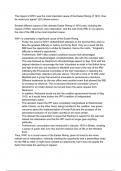The impact of WW1 was the most important cause of the Easter Rising of 1916. How
far would you agree? (20) (Modal answer)
Several different causes of the ultimate Easter Rising of 1916 exist, including the
impact of WWI, carsonism, new nationalism, and the role of the IRB. In my opinion,
the role of the IRB is the most important cause.
WW1 is undeniably a significant cause of the Easter Rising.
- Firstly, the event of WW1 shifted British attention to the fact that they were to
face the greatest difficulty in history and firmly fixed. Only as a result did the
IRB have the opportunity to strike for freedom. Hence the motto, “ England’s
difficulty is Ireland’s opportunity”.
- Furthermore, WW1 also created a political vacuum that advantaged
separatists and disadvantaged constitutionalists, like with the volunteer split.
This was followed by Redmond’s Woodenbridge speech in Sep 1914 with the
original intention to encourage the Irish Volunteers to enlist in the British Army
and fight in the war, but resulted in MacNeill and most of the rest of the IRB-
infiltrating the Provisional Committee of the Irish Volunteers in rejecting the
call provided their collective anti-war stance. This left a rump of 12,360 under
MacNeill and a group that would be amenable to revolutionary intentions.
- Different treatments by the war office were another event that allowed the IRB
to increase its influence. This is because Kitchener conceded Carson’s
demand for an Ulster division but turned down the same request from
Redmond.
- In addition, Redmond would not join the coalition government formed in May
1915, as it would have broken the IPP’s tradition of independent
parliamentary action.
- This decision meant the IPP were completely marginalised at Westminister
while Carson, on the other hand, being included in the coalition, has grown
concerns about the implementation of Home Rule and the prospect of the
permanent exclusion of six Ulster counties to be more certain.
- This allowed the separatists to argue that Redmon’s support for the war had
diluted his nationalism and that the IPP could no longer gain anything
politically.
- Furthermore, conscription was introduced in January 1916 in Britain, creating
a sense of public fear over this and the massive loss of life on the Western
front.
Thus, WW1 is a crucial cause of the Easter Rising, given its boost to the more
radical end of nationalism, indirectly creating the opportunity and a paramilitary body
for the IRB to rebel. It might have created an opportunity, but it was not exactly the
factor that made the uprising to happen.
, The cause of Carsonism has also been argued to have “rekindled the Fenian flame”.
- Edward Carson and the Ulster Unionists' campaign of opposition against
home rule undermined Redmond and the IPP.
- The signing of the Solemn League and Covenant, preparations to form a
provisional government, and the formation of the UVF and subsequent
gunrunning represented the development of an extra-parliamentary strategy.
- The example of the Ulster Unionists' extra-parliamentary strategy, gun
running, has inspired the formation of Irish volunteers to highlight Redmond’s
ineffective constitutional strategy.
- Hence, in November 1913, MacNeil called for the formation of Irish Volunteers
in response to the UVF.
- Casonism had converted a significant number of Home Rulers, like Partirck
Pearse, into radical nationalists, reviving the IRB organisation with manpower.
This suggests a major influence, yet not as much of an important cause of the Easter
Rising in comparison to WW1 or the role of the IRB.
Another key cause of the Easter Rising is the new nationalism.#
- This is to do with a romantic vision and revolutionary spirit of a free Gaelic
Ireland.
- Towards the end of the 19th century, the idea that Ireland had a distinctive
cultural identity began to take hold.
- The cause of cultural nationalism was helped by a growing disillusionment
with constitutional nationalism, as seen with the failure of the first two home
rule bills in 1886 and 1893, and the failure of the 2nd home Rule bill
convinced many nationalists that their aims could not be achieved by
constitutional means.
- Instead, they sought to create a distinct Irish identity, which could one day be
used to forcefully assert Irish identity
- A key manifesto was the growth of cultural nationalism - as reflected by the
Gaelic Athletic Association, the Gaelic League, and Literacy Revival. In the
Gaelic League, the revival of the language gave Ireland a claim to nationality.
- This language movement especially attracted young men of talent or ambition
who felt politically excluded by the established forces of constitutional
nationalism.
- Not only did it boost the separatist movement, but more importantly, it was
from this group that the Irish revolutionary elite emerged, and such leaders
formulated the rationale for the rebellion and a programme summarised in the
1916 proclamation.
- Furthermore, the cultural revival sparked feelings that they could only
continue through the use of physical force. As Pearse suggested, “bloodshed
is a cleansing and sanctifying thing”.
Therefore, new nationalism created the atmosphere for an uprising but again not the
direct cause of the Easter Rising of 1916.




